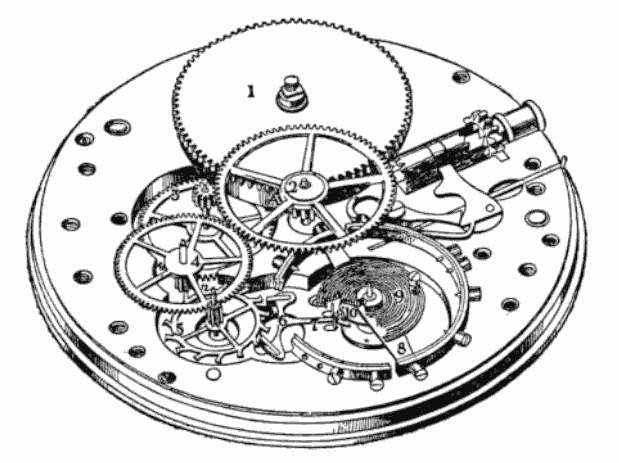
Analyzing a movie can be like taking apart a mechanical watch. I imagine a Swiss pocket watch, with a chain that clips onto a vest pocket. Peter Rinaldi has written that Absolute Beginners is a movie that doesn't always work. It's the watch that has to be set a little too often. So let's play the repairman. Let's take the watch apart on our little work bench and break it up into the little gears and bits of sub-machinery that make it run. I'll use the above diagram, made in 1919 by Harry Chase Bearley, as my guide. So, loupe firmly planted in my eye, here are the first parts I see:
1.First or main wheel to which mainspring is attached
This large wheel makes me think of the revolving floor at the film's upscale party, which in turn made me think of the revolving stages used by well-funded theatres: the kind where several sets are built so that they can be rotated in and out between scenes.
Absolute Beginners is a film that could only be made on a sound stage and a back lot. The artificiality, the careful design of the settings, gives it a hyperreality unachievable in location shooting (conversely, there is a dream-like element that is only possible to achieve by shooting on location).
Another film springs to mind, made the year before: Year of the Dragon, by Michael Cimino. Cimino originally set out to shoot the film in Chinatown, but when that fell through, he had sets built in North Carolina (like the set of Leos Carax's Les Amants de Pont-Neuf, a gigantic recreation of Paris built in Montpellier). Had Year of the Dragon been shot in the real Chinatown, it would have been a very different film.
The cutaway set of Colin's house uses an image (found, as mentioned by Peter, in The Ladies Man, Tout Van Bien and The Life Aquatic, to name a few) that, despite its roots in theatre, has a fascinating effect in cinema. It allows us, in a single framing, to see several things going on at once, giving us a view of reality that's very different from the way we actually perceive it (see also: a previous Film of the Month, The Intruder). It is the ultimate wide shot, one that shows reality wider than we can ever actually experience it, showing connections between physically separated elements (another ancestor: the translucent floor in Hitchcock's The Lodger, which shows the feet of the upstairs neighbor; if there was ever an image that made a case against the concept of a "silent" image, this is it). This very complicated image is united by a single sound: a song.
8.Balance
Here is a movie that spends its first two-thirds as a musical comedy and then becomes a melodrama in the strictest definition of the term: a fictional performance (-drama) with songs (melo-).
3.Third wheel
Reading the name of this part makes me interpret it idiomatically, as the thing with no useful purpose that unbalances something. The extra person. But of course nothing is ever useless. An arbitrary addition creates something new. A work is made up of all of its elements, not just the ones that have a clear function. The credits in a movie last just as long as a scene, so why don't they ever get discussed (after all, they're part of the movie, too)? And the opening (photographs on a red background with the names of important individuals) and closing credits (scrolling upwards over a long shot of movie rain pouring down on the set) are set to the same song: "Absolute Beginners." Which points the way to the third wheel in the production: David Bowie, who gets high billing on most advertising for the film despite playing a fairly small part.
Bowie wrote the song to the film under the condition that he also got a role. It's Bowie's baritone ad man who steers the film towards Tashlin when it wants to go Minnelli. Bowie's musical number, it should me mentioned, was written by the singer himself .
9.Hairspring
The hairspring of a watch is the coiled piece of metal that regulates its movement. Our first instinct is to think of the script. First instincts must be resisted. Scripts have the distinction of being the only part of a film that can be tossed into a waste basket.
The film could be structured by the musical score, a combination (like the film itself) of a little original composition and a lot of adaptation, mostly of decades-old pieces. The bulk of it is by Gil Evans, but most of the musical numbers are composed by the performers: Ray Davies' "Quiet Life," the aforementioned Bowie song ("That's Motivation"), Tenpole Tudor's ode to Ted culture and the little cameo performances, like Sade's number in the club. Attempting to be commercially successful by cashing in on the popularity of these singers, the film gives the music the first priority in terms of how it should pace itself.





2 comments:
The parts of the watch labeled in the diagram but not mentioned in the post are:
4. Fourth wheel
5.Escape wheel
6.Pallet, with pallet jewels
7.Lever
10.Roller
Very interesting post. I suppose we should add MacInnes' novel to the Hairspring.
This film does not always "keep time", but if you let yourself believe that the time it displays is the right time, there are rewards.
Post a Comment